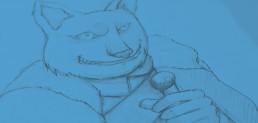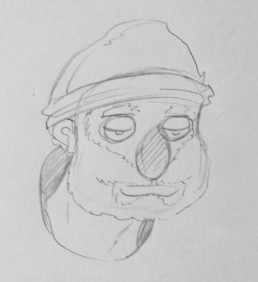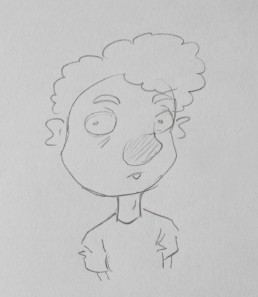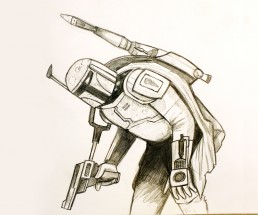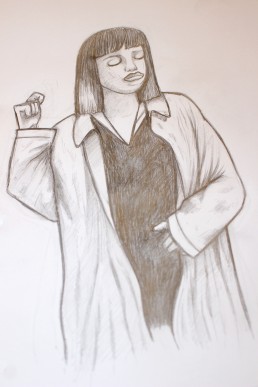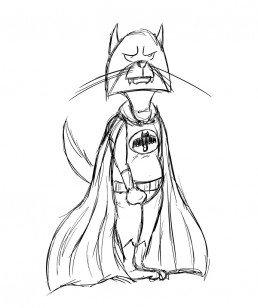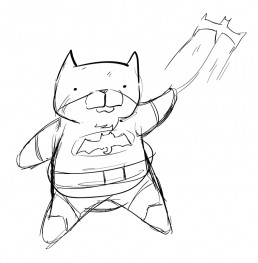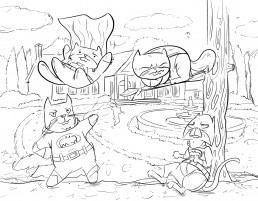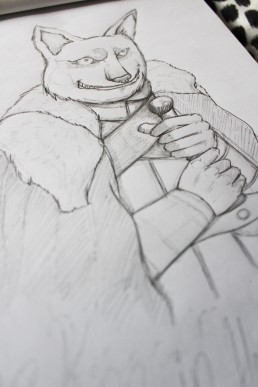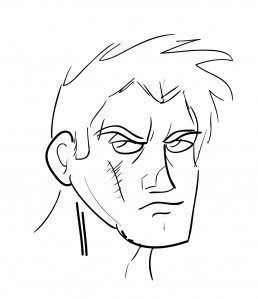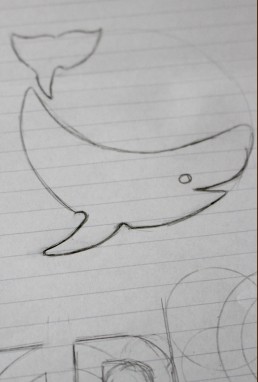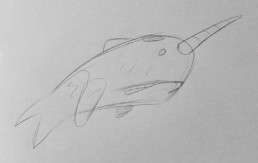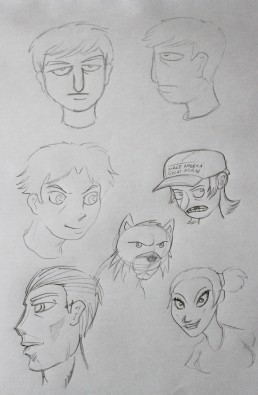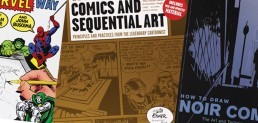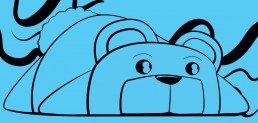10+ Ways illustration can improve your business today
1 - Spice up your blog posts and take them to the next level
A lot of companies will choose from any number of button styles or a plethora of illustrated icons that are available to them in stock format. However if you really want to stand out, be original and add value to your brand some companies choose to hire an illustrator to create bespoke icons and buttons for use on their website and other branded materials.
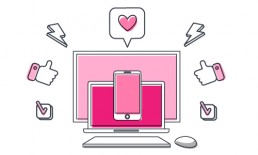
2 - Display information in interesting ways with infographics
it’s no secret that infographics are a great way to draw in audience engagement and also one of the best ways possible to deliver interesting or even monogamous stats in a visually pleasing way that will keep the reader from getting bored. If you think you have valuable information that isn’t getting the attention it deserves, infographics are a great way to rectify this pain point.

3 - Illustrated versions of your branding or brand characters
Branding and position are hugely important to companies especially in today’s busy marketplace. Why not take advantage of one of the many talented illustrators out there and add a little animation and life to your branding with an illustrated version or even an illustrated character to represent your branding.
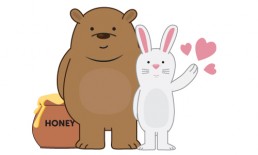
4 - Use illustration or mograph instead of photo posts on social accounts
your audience can get weary of seeing the same old promotional posts and advertising on their feed. Illustration allows you to quickly tap into those emotional centres of childhood and evoke emotions photos and other more polished marketing information just can’t reach. Why not improve your social media presence with some well-placed illustrations.
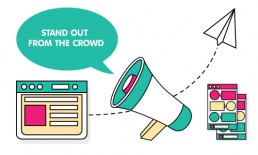
5 - Personalised icons or buttons to fit your brand or help you stand out from the crowd
A lot of companies will choose from any number of button styles or a plethora of illustrated icons that are available to them in stock format. However if you really want to stand out, be original and add value to your brand some companies choose to hire an illustrator to create bespoke icons and buttons for use on their website and other branded materials.
6 - Clever business cards that will stand the test of time
Business cards can be a dime a douzen, they can be completely disposable or as per the business card scene from American Psycho they can really stand out. A great illustration can turn your business card from something mundane and disposable to something worth keeping or pinning to a board on the wall as a shining example of how to do personal branding right. On that point why not have an illustrator create an image of you that encapsulates your personality and add an extra layer of connection to your potential client.
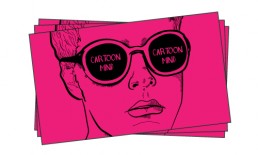
7 - Illustrated digital or print advertisement campaigns
As mentioned earlier, illustration is a great way to connect with your audience on a different level and in advertising it’s no different regardless of digital or printed medium. Some of the biggest brands in the world turn to illustrators to create unique marketing campaigns, for instance the ‘redbull gives you wings’ campaign was a huge success that still runs to this day and that’s all thanks to the unique wonderful illustrations that can be viewed here http://cartoons.redbull.com/uk-en/ – this is a great example of how to use illustration not just for advertising alone but your branding on a whole.

8 - Shareable social media branding and banners
As I’ve said with social media posts your social media presence is no different. This is yet another great way to use some unique art to really stand out in a crowded social marketplace. Your competitors may use something simple that fits in with their brand colours but you’ll have people clicking like a lot quicker, harder and more often with an illustrated touch.
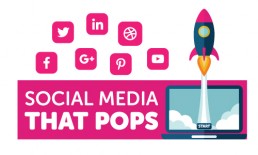
9 - Add personality and fun to your websites about page with illustrated portraits
Companies and individuals alike love an about page on their website. It lets the person visiting your site know who it is they’re thinking about doing business with. Whether you use a real image that rolls over to an illustrated concept or just an outright illustrated portrait you can really add some fun to your site and customer engagement with a well-placed illustration.
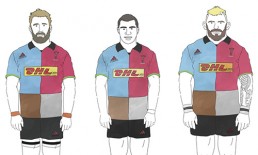
10 - Make your book cover or PDF download stand out in a crowded marketplace
A lot of companies are turning to self-publishing and ebooks at the moment in order to spread their brand message and make passive income. It’s a fact that if you were to visit the amazon store and look at the books that sell the best – they all have at least one thing in common. The front cover looks professional, like they used someone with the know-how and skills to make that cover look great. Between illustrators and graphic designers this is a way your book can end up on the best sellers list instead of in a bargain bin. Make a cover that stands the test of time and stands out as a beacon in its niche with a great looking front cover!
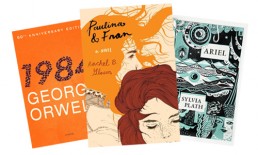
11 - Use personalized thankyou notes and gifts to stay memorable
A great way to say thank you to a customer or consumer, or even to show gratitude and build a relationship is to send a thank you note or gift from time to time. An illustrated version of this can come off as warm and friendly rather than cheesy pandering and adds a little personal touch to your brand message. Not to mention if you were to have your top clients illustrated and put on a Christmas card, they’d be sure to remember you come January for going that extra mile and thinking outside the box when it comes to your branding.
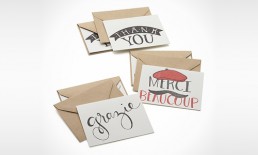
11 - Use engaging discounts and coupons to really boost your business potential
Discounts are a great way to launch a new product or increase sales as are coupons but as with all the points mentioned here engagement is key and what gets the word out better than a well-designed illustrated discount or coupon.
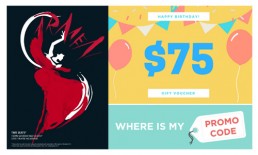
12 - Packaging and labels that stand out on shelves or in eCommerce stores
Packaging design and labels can be a huge part of a business if you’re producing a product or selling to a marketplace. Illustrators are a great way to improve and enhance your packaging and labels and tailor your products to the right market. The right illustrator can create you packaging that not online stands out on a shelf but in a busy eCommerce shop. The more interesting the packaging, the prettier it is – the more likely someone is to buy!

September 2017: Art Dump
September 2017: Art Dump
What do we do with all those creative projects that don’t quite make the grade. The rough sketches, the outlines of ideas that never quite come to fruition. We dump them all in a blog post for people to enjoy 🙂 Here’s some of my rough work from this month.
10 must have illustration books
10 Must have illustration books
As the saying goes, good artists copy – great artists steal. Now I’m not suggesting you go out and steal anyone’s art or copy it for that matter. This is reference to the fact that if you were to borrow inspiration from multiple sources and let that inform your work and develop your skills then you’ll be much better off as an artist in the long run. The great thing about being a creative like an illustrator or a designer is there’s a plethora of work out there to draw from and plenty of amazing advice and practical tips to borrow from. below are my Top 10 must have illustration and art books.
1. How to draw comics the 'marvel' Way - By Stan Lee (1986)
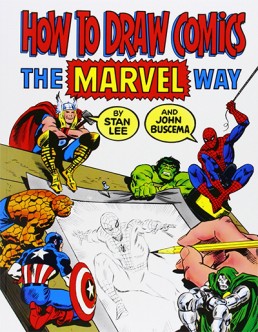
Like many budding artists as a child my first love was in animation and comic books. This book in particular holds a special place in my library as it was the first art-book I got as a child I remember being genuinely excited about. Still as useful today as it ever was how to draw comics the marvel way covers a huge range of topics from the tools of the trade, poses, drawing action scenes and rendering art to give it a 3 dimensions space and feel. This is a great starting point for any illustrator with a love of golden age comics who wants to learn the basics and develop there way to more advanced techniques. As well as learning the fundamentals of the marvel techniques for character design while owning a great piece of art and illustration history.
2. Comics and Sequential Art: Principles and Practices from the Legendary Cartoonist - By Will Eisner (1985)
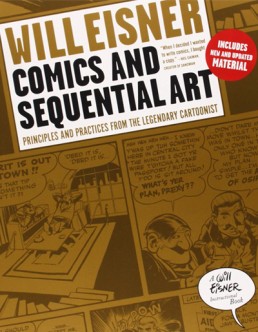
Described by a Pulitzer prize-winning author as a masterwork. This distillation of Will Eisner’s genius is a must have for any animator or illustrators library. Eisner was one of the first cartoonists to work in the American Comic industry and popularized the term graphic novel and the Eisner award is still equated as the comic industries equivalent of the Oscars. Suffice to say the guy knows his stuff and when it comes to sequential story telling, that is, telling a story in still images. The information in this book is invaluable!
3. The Animators Survival Kit - By Richard Williams (2001)
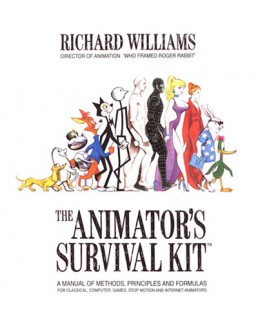
When I was looking to get into animation this is the book that popped up as a must own for any budding animator. If you want to add motion to your illustrations in the future than this is the best start you can give yourself in learning the fundamentals. Written by an academy award winning animation effects artist Richard Williams has built an outstanding reputation and with work on his CV like Toy story and to a lesser extent… Star Wars: The Phantom Menace – you can see why this is one of the most popular books on animation available.
4. How to Draw Noir Comics: The Art and Technique of visual storytelling - By Shawn Martinbrough (2007)
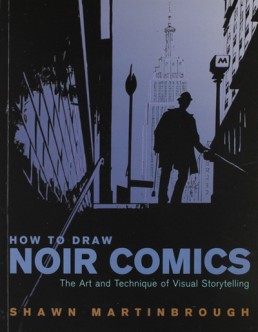
If like me you’re a fan of dark angles, shadowy, high contrast images, moody lighting, silhouettes and use of negative space combined with a dark and gritty tone driven by moral conflicts then this book is perfect for you. Martinborough’s has the ability to take art that should have a retro 1940’s vibe and make it contemporary and compelling as well as dramatic and urban. If you’re interested in developing your noir art style or your sequential storytelling in general this is a great read.
5. Giger ARh+ (Basic Art) - By H.R Giger (2001)
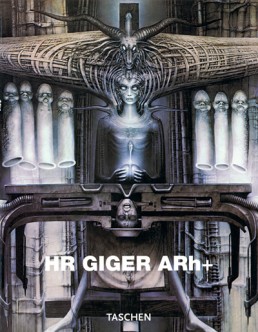
Though not a book on how to illustrate or create, this one’s a personal addition as Giger is one of my all time favorite artists. Over three decades he created some of the most fantastic industrialized surrealist art known to man. Combining machinery, sex and sadomasochism, he even found time to create the concept art for aliens. That’s right, without this man there would be no Xenomorph and a huge chunk of my childhood and yours would probably be missing. I highly recommend indulging in the mans dark and grimy art. It’s well worth a trip!
6. The Art of Pixar: 25th Anniversary - Amid Amidl (2011)
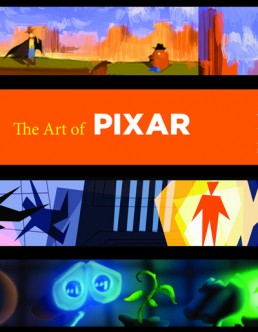
Another art book entry but there’s absolutely no question why I’d include this one on the list. Of all the animation studios today that are putting out feature length productions, pixar are for all intensive purposes ahead of the game. It takes a lot to over take disney but between Toystory and other massive franchises they’ve managed to do it. This is a great collection of the artwork they’ve produced over the last 25 years, a great gift, coffee table book or inspiring work for any budding illustrators collection.
7. Constructive Anatomy - By George B Bridgman (2000)
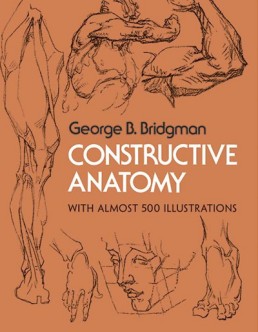
Though not the most exciting title on this list it is extremely important to learn anatomy when it comes to drawing. If your proportions are all out of whack it can be a stylistic choice but as they say, you need to learn the rules before you break them. Anyone serious about their artistry and improving will at some point most likely want to draw real human people. In order to do that effectively they need to know the human anatomy as well as possible – this is a great book for that purpose.
8. Drawing cutting edge anatomy - By Christopher Hart (2004)
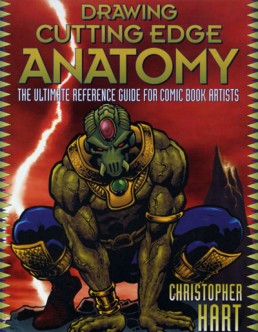
Now that we’ve covered the realistic side of human anatomy and art it’s time to have some fun and break the rules. This is a fantastic comprehensive guide to comic book anatomy. Taking you from the basics right down to individual body parts and muscle groups – hart covers all the extremes when it comes to playing with proportions.
9. The art of drawing Manga - By Ben Krefta (2009)
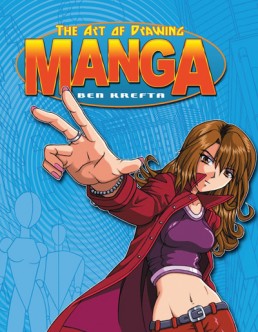
Though there are a huge range of how to draw Manga books on the market this is one I can personally vouch for. A great comprehensive guide to the fundamentals of the most popular art form in Japan. With anime constantly growing in popularity with western audiences and being accepted in the mainstream thanks to Studio Ghibli and Netflix bringing shows like Attack on Titan and Death note to the attention of mass audiences, it’s a great time to get involved in the world of Manga art. This is a great place to start developing elements of what makes up the ‘anime’ or ‘manga’ art style that has become so popular.
10. How to draw cartoons and caricatures (2013)
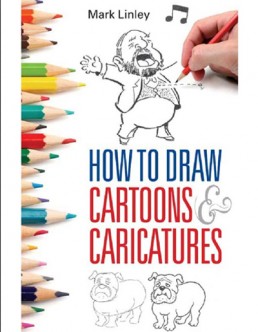
This is a fun book and one that proves that everyone car draw once they grasp the basics rule of art, that is – everything is made up of simple shapes. It is how we combine and exhilarate those shapes that create style and interesting substance. If you’re wanting to start drawing fun cartoons of your pets or creative funny sketches of friends or colleagues this book will tell you how to draw and exhilarate features while making things fun in the process.
I hope you enjoyed this list, obviously these are just some personal favorites and recommendations for getting started and improving as an illustrator. I hope you enjoyed it but if you disagree with any of the entries or have some books you’d like to recommend yourself, feel free to leave a comment or find me on social messenger and we can have a bloody lovely chat.
– Tom
How to create a pressure sensitive custom brush in Adobe Illustrator
How to guide - Creating a pressure sensitive custom brush in Illustrator
In this how to course we’re going to cover how you go about creating a pressure sensitive calligraphic brush in illustrator, that will allow you to have complete control over your line weights when drawing with a graphics tablet. Whether you want to create more depth or just play around this brush is perfect for giving you the variation of ink in a digital format.
Step 1 – Create new brush
Navigate to the brushes palette in Adobe Illustrator (Window>Brushes) or F5. One the brushes panel is open move your cursor to the upper right and click the small menu line icon. Then click new brush to create a new custom brush.
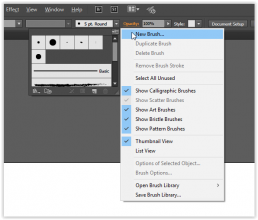
Step 2. Select Calligraphic Brush
A menu will appear pop up titled ‘new brush’ where you can select a brush type – select the top option ‘Calligraphic Brush’
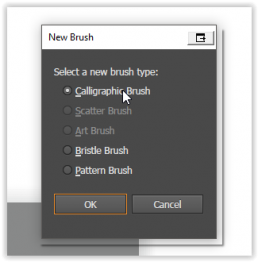
Step 3. Select pressure from the size drop down menu
Next to the size option at the bottom where the slider is you will see the word ‘fixed’ select this and from the drop down select ‘pressure’
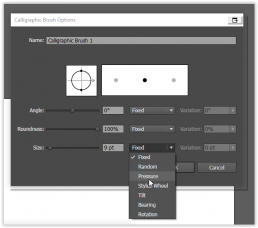
Step 4 – Change the variation
Alter the variation of the size to the right hand side of the drop down. Remember that the more variation between the initial brush size and this value will create more pressure variation to the line weight when using your tablet to draw.
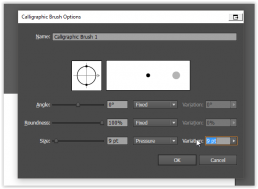
Step 5 – Select the paintbrush tool
After accepting the creation of your custom brush make sure that the Paintbrush tool is selected. (You can also use the blob tools and other tools in unison with your new pressure brush)
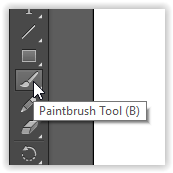
Step 6. Select your stroke colour
You can now select the colour you want to use for your brush, in this instance I’m selecting black. You don’t need to alter the stroke weight as this will be done my the pressure sensitivity of your tablet in this instance.
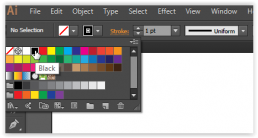
Step 7. You can view and edit your brush at any time
Now you’ve created your brush you will be able to see it in the brushes menu. You can double click and change the values of the brush at any time and this can be applied to only new strokes or retroactively applied to lines you’ve already drawn with the pressure sensitive calligraphic brush.
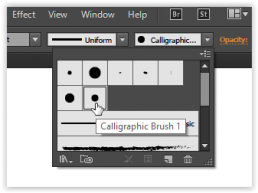
Step 8. Draw till your hearts content
You’ve now created a pressure sensitive brush in illustrator that will work in unison with your graphics tablet to work the way a real calligraphic brush does. This will give you great freedom over line weight and can really make your artwork pop. The variations and uses are limitless.
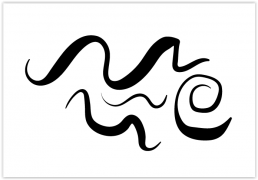
For the purposes of this tutorial I used a copy of Adobe Illustrator and a Wacom Bamboo tablet. They’re available on amazon and aren’t the top of the line but durable, usable and responsive. I’d highly recommend checking one out if you’ve ever been curious about using a tablet.

